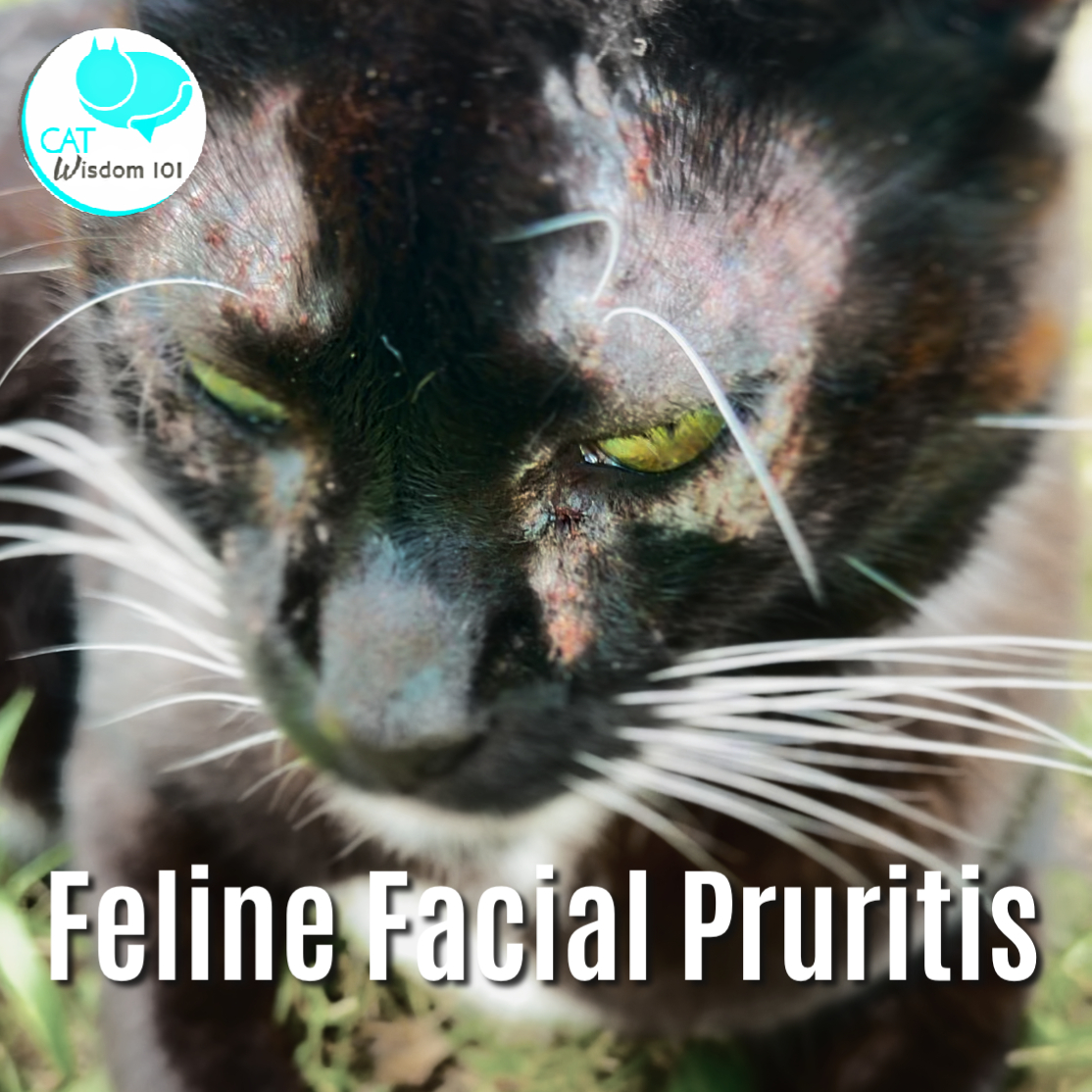
Feline Allergies: Itchy Facial Pruritis
Feline Allergies: When Your Cat’s Skin Tells a Tale of Facial Pruritis.
This post was inspired by my cat Otto: his recent bout and successful treatment of facial pruritus.
I’ve seen my fair share of itchy, uncomfortable cats. One of the most common issues is allergies, which can manifest in various ways. Today, I want to focus on two particular symptoms that often leave cat owners scratching their heads: hair loss and crusty skin on the face.
First, let’s talk about hair loss. If you notice your cat developing bald patches or thinning fur, especially around the base of the tail or on the belly, allergies could be the culprit. Cats with allergies often over-groom, leading to these telltale signs.
First off, let’s talk about what facial pruritus actually looks like. It’s not pretty. Otto went from from normal to hideous within three days.
Usually the hair loss is above the eyes, but that’s not the only place you might see it. Some cats get patchy around their ears, others might have thinning fur on their cheeks or chin.
And here’s a fun fact for you: some cats with facial pruritus develop something we call a “miliary dermatitis.”
It’s basically a rash that feels like tiny little millet seeds under the skin. Your cat won’t appreciate you feeling for it, trust me!
This condition appears as small, crusty bumps, typically around the chin, lips, and sometimes extending to the neck. It’s often accompanied by intense itching, causing your feline friend visible discomfort.
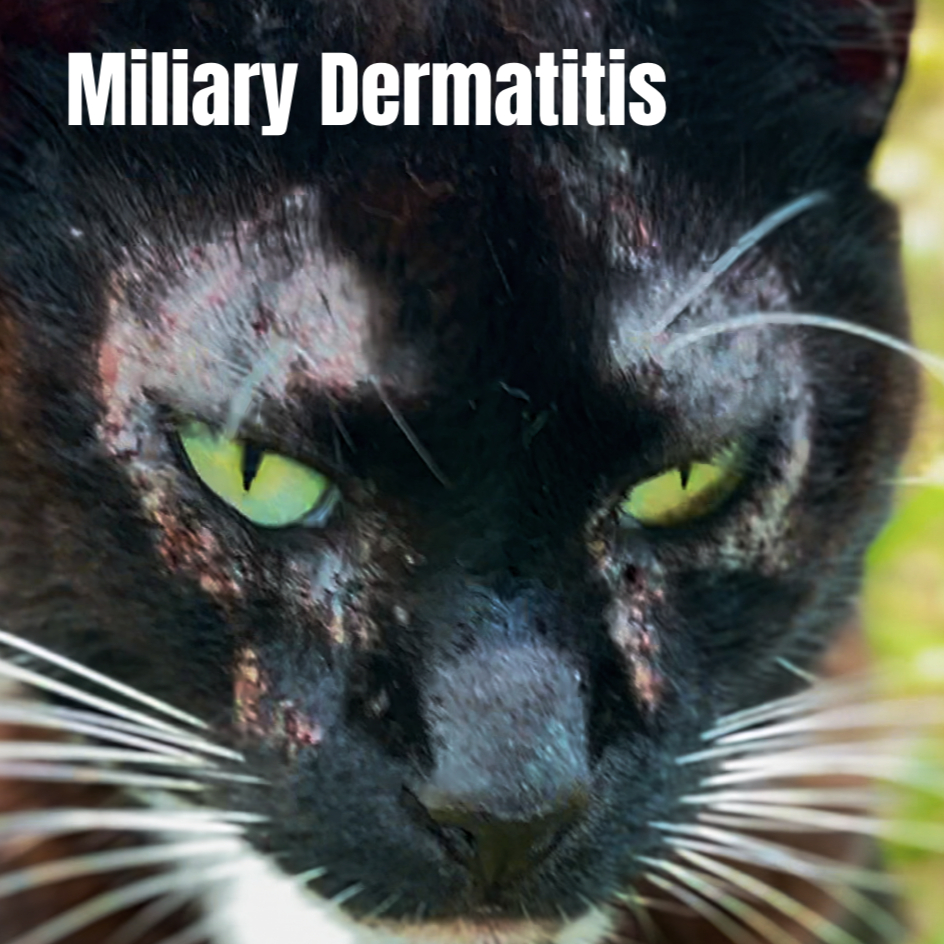
So, what’s causing these allergies? Common triggers include:
1. Environmental allergens (pollen, dust mites, mold)
Environmental allergies, or atopy, is another biggie. This could be seasonal, like pollen allergies, or year-round, like dust mites or mold spores. Some cats are even allergic to human dander. Imagine that your cat being allergic to you!
2. Food allergies
Food allergies in cats are less common than environmental allergies, but they can cause similar symptoms, including the hair loss and facial skin issues we discussed earlier. Here’s what you need to know:
Common Allergens:
The most frequent food allergens for cats are usually proteins. Contrary to popular belief, grains are rarely the culprit. Common allergenic proteins include:
1. Beef
2. Dairy
3. Fish
4. Chicken
5. Egg
Remember, food allergies can develop at any age, even to foods your cat has eaten for years without issues. If you suspect a food allergy, don’t hesitate to consult your vet.
3. Flea allergies
Now, let’s talk about some of the less common causes. Flea allergy dermatitis is a real thing, and some cats are so sensitive that one flea bite can set them off.
There’s also a condition called psychogenic alopecia, where cats overgroom due to stress or anxiety. It’s like the feline version of stress-eating, except instead of ice cream, they’re munching on their own fur.
There’s the immediate type, where your cat reacts right away to something, and then there’s the delayed type, where it might take days or even weeks for symptoms to show up. This is why pinpointing the exact cause can be trickier than getting a cat into a carrier on vet day.
Our vet suspected seasonal allergies was the cause of Otto’s hair loss but
Detecting the specific cause can be tricky, but here’s the tried-and-true approach:
1. Rule out fleas: Even if you don’t see them, treat your cat for fleas. You’d be surprised how often this solves the problem.
2. Food trial: If flea treatment doesn’t help, try an 8-12 week hypoallergenic diet. This means no treats, no table scraps – just the prescribed food.
3. Environmental testing: If the food trial doesn’t yield results, we might need to look at environmental allergies through intradermal skin testing or blood tests.
Diagnosis can be a bit of a journey. Your vet might start with a physical exam and some basic tests to rule out other issues like mites or fungal infections. They might recommend a food trial, where you switch your cat to a hypoallergenic diet for a few months. Blood tests for allergies exist, but they’re not always reliable in cats. Sometimes, we even do skin tests, similar to what humans get for allergy testing.
Treatment
Treatment options vary based on the cause but may include:
– Antihistamines
– Omega-3 fatty acid supplements
– Topical treatments for skin relief
– Immunotherapy for environmental allergies
– Corticosteroids (in severe cases, under strict veterinary supervision)
Treatment, as you might guess, depends on the cause. If it’s food allergies, we’re looking at a diet change. Environmental allergies might mean some lifestyle changes, maybe some meds to control the itching. In some cases, we can even do immunotherapy, basically, allergy shots for cats.
Cortisone
The most common treatment is cortisone. Otto had a titered two week treatment. The healing progressed quicky and all his fur grew back in 3 weeks.
Cortisone, or more broadly corticosteroids, can be a real game-changer for cats with facial pruritus. Here’s the scoop:
1. How it works: Cortisone is an anti-inflammatory and immunosuppressant. It basically tells your cat’s immune system to chill out, which can really help with allergic reactions.
2. Forms of treatment: We’ve got options here. There are liquid, oral tablets, injections, and even topical treatments. The choice often depends on how severe the issue is and how cooperative your cat is (we all know some cats are pill ninjas!).
3. Quick relief: One of the big pros of cortisone is that it often provides rapid relief. Your itchy kitty might be feeling better in just a day or two.
4. Short-term use: Usually, we use cortisone as a short-term solution. It’s great for breaking the itch-scratch cycle and giving your cat some immediate comfort.
5. Potential side effects: Like any medication, cortisone isn’t without its downsides. Short-term use can increase thirst and appetite. Long-term use can lead to more serious issues like diabetes or weakened immune system.
6. Not a cure-all: While cortisone treats the symptoms, it doesn’t address the underlying cause. That’s why we often use it in conjunction with other treatments or as a stopgap while we figure out the root of the problem.
7. Prescription required: This isn’t something you can just pick up over the counter. Your vet will need to prescribe it and determine the right dosage for your cat.
8. Tapering off: If your cat’s been on cortisone for more than a few days, we usually taper off the dose rather than stopping abruptly.
Remember, while cortisone can be super effective, it’s not the right choice for every cat or every situation. Your vet will weigh the pros and cons based on your cat’s specific case.
And here’s a pro tip: if your vet does prescribe cortisone, make sure to follow the instructions to a T. Consistency is key with this medication.
So there you have it! Cortisone can be a powerful tool in our arsenal against facial pruritus, but it’s just one piece of the puzzle. Always work closely with your vet to find the best treatment plan for your furry friend
Here’s something important to remember: facial pruritus isn’t just a cosmetic issue. Sure, those bald patches aren’t winning any beauty contests, but the constant itching can really impact your cat’s quality of life. It can lead to skin infections, behavior changes, and even affect their sleep. So if you notice your cat scratching more than usual, don’t wait to get it checked out.
Lastly, let’s talk prevention. While you can’t always prevent allergies, there are things you can do to help your itchy kitty.
Regular grooming can help remove allergens from their coat. Using air purifiers and keeping your home clean can reduce environmental triggers. And of course, a high-quality diet and regular vet check-ups are always a good idea.
In my experience, catching and treating allergies early can make a world of difference. If you notice your cat exhibiting hair loss or crusty facial skin, don’t wait. The sooner we address the issue, the happier and more comfortable your cat will be.
Lastly, a word of caution: never attempt to treat your cat with human medications without consulting your vet. What’s safe for us can be deadly for our feline companions.
Remember, every cat is unique, and what works for one might not work for another. It might take some time and patience to figure out what’s causing your cat’s facial pruritus and how to best treat it. But hey, that’s what being a cat parent is all about, right? Solving mysteries and keeping our feline overlords happy and healthy.
Otto is back to his normal, happy, handsome and healthy self.
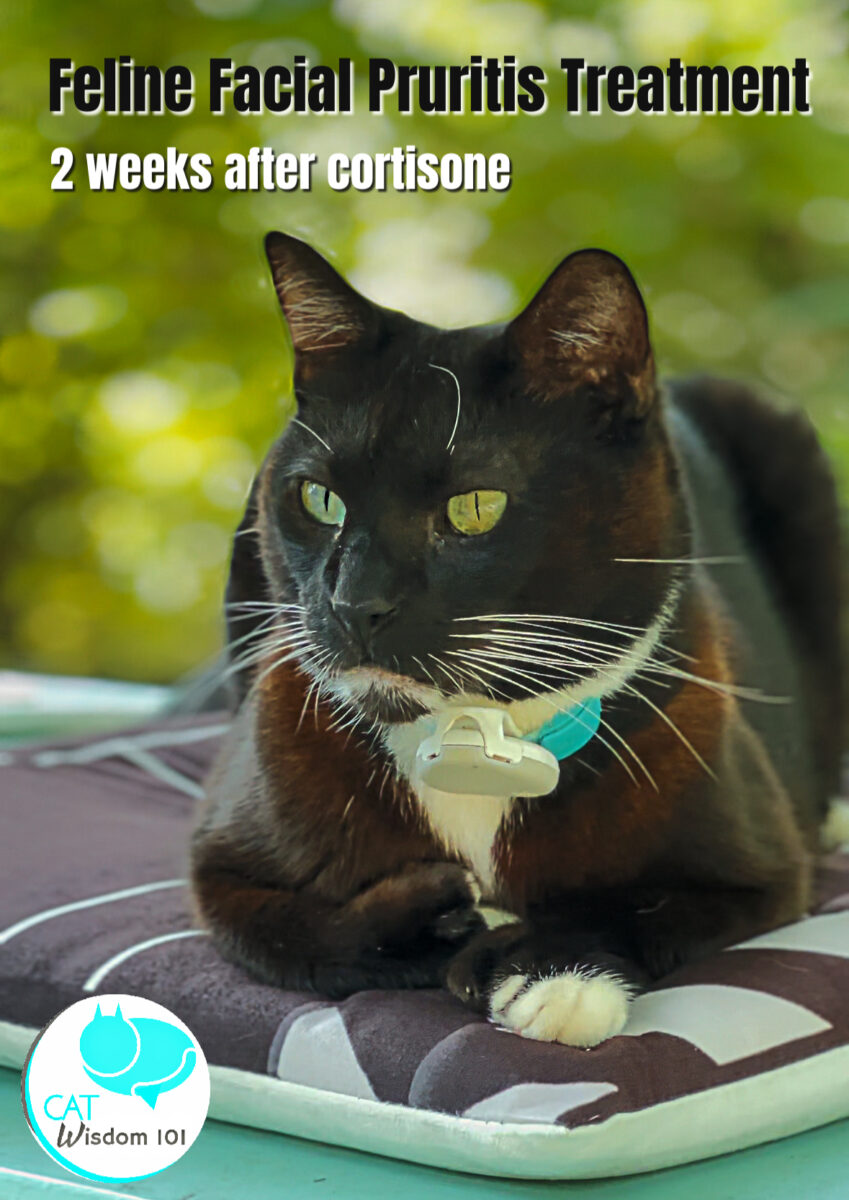
So there you have it, folks, a deeper dive into the world of feline facial pruritus. Keep those eyes peeled, those lint rollers handy, and don’t hesitate to chat with your vet if you’re concerned. Your cat’s face (and the rest of them) will thank you!
Stay curious about cat care, cat people!
Love,
Layla and Otto



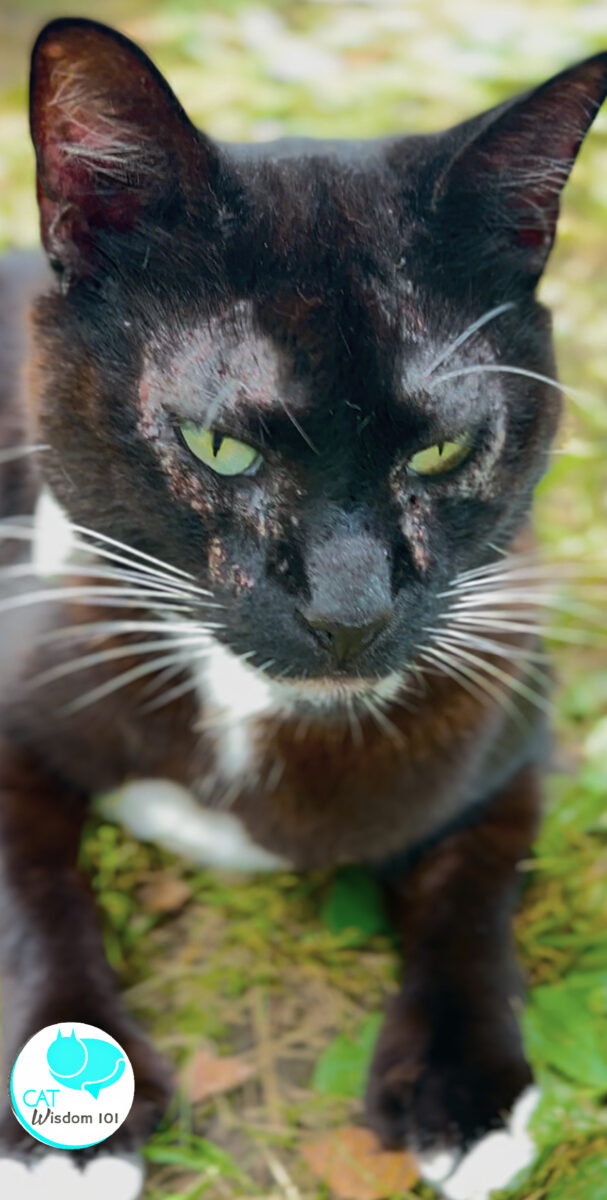
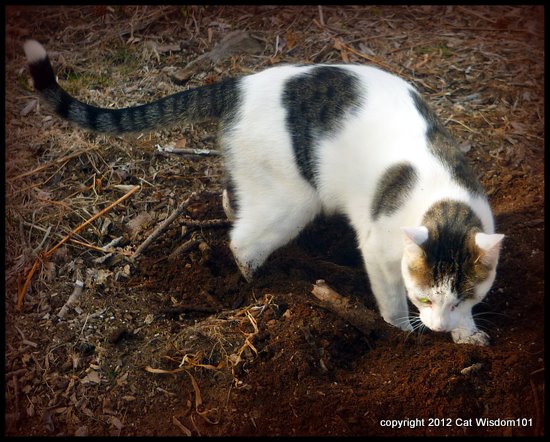
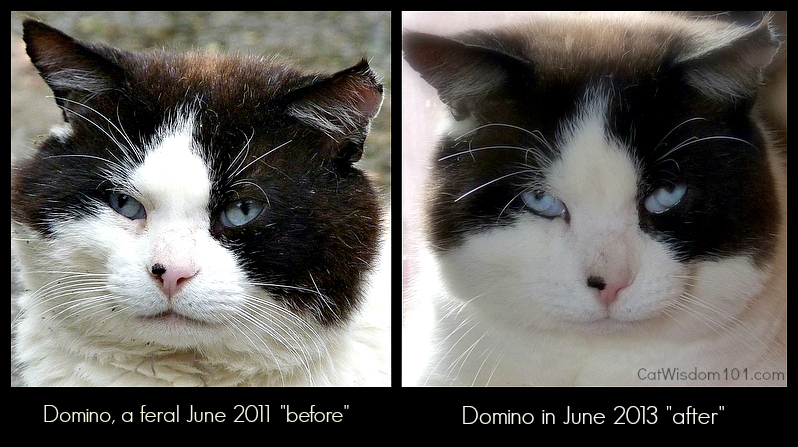

8 Comments
Meezer'sMews&TerrieristicalWoofs
I’m glad Otto got better. Steroids really are a miracle drug, and so helpful for both peeps andanimals…if used with good judgement.
Marjorie Dawson
This is an essential post that I will add to my social sgares. People may not realise tghis. Allergies can be so painful and uncomfortable.
I am so glad Otto is doing better and it did me good to see the ‘after’ photo where he showed how vet care and careful human attention transforms a cat
Layla Morgan Wilde
thanks so much, Marjorie. It’s so important to seek help quickly.
meowmeowmans
Poor Otto. We’re so glad you have a great vet and Otto’s doing so much better!
Layla Morgan Wilde
thanks, as you well know, a good vet is gold.
Ellen J Pilch
Interesting post. I hope my cats never get this. XO
Brian's Home ~ Forever
None of those are fun at all and yes, figuring out the exact problem is a real challenge!
Layla Morgan Wilde
True! I’m grateful for our good vet.